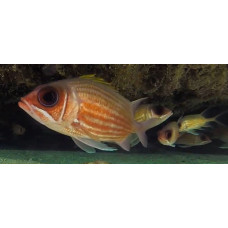Latin name
Holocentrus adscensionis
Other names
Holocentrus adscensionis
Identification
Body elongated, slightly compressed at the sides, oval in shape, covered with large ctenoid scales. The upper jaw extends beyond the vertical line passing through the centre of the pupil. The eyes are large, resembling squirrel eyes. There are small villous teeth on both jaws and in the upper part of the mouth.
Features of fish fins
The dorsal fin has 11 hard and 15-16 soft rays. The anal fin has 4 spiny and 9-10 soft rays. The caudal fin is severely truncated. The soft part of the dorsal fin and the upper lobe of the caudal fin are elongated.
Fish colouring
The body is dull red or pinkish with a golden tinge, with silvery stripes along the body. The underparts and abdomen are white. The top of the head is dark red. The lower jaw and the top of the upper jaw are white. The iris near the pupil is red. The barbels on the dorsal fin are yellowish or yellowish-green.
Distribution
Widespread in tropical and subtropical waters of the Atlantic Ocean. Western: from North Carolina and Bermuda to Brazil, including the Gulf of Mexico. Also found off the Caribbean and the Bahamas. Eastern Atlantic: St Helena and Ascension Island, along the west coast of Africa from São Tomé Island and Gabon to Angola.
Habitat
Marine subtropical species. Can be found in both deep open water and shallow areas around coral islands at depths of up to 180m, more commonly down to 30m.
Size
Reach a maximum length of 61 cm, usually around 25 cm.
Behavior
They are nocturnal and hunt over sandy substrates and in thickets of aquatic plants. During the day they hide in crevices or under reef ledges. Juveniles are grouped in schools and adults show territorial behaviour. Can make sounds using a swim bladder. While in a crevice, they make sounds similar to grunting. In the presence of larger individuals or predators, they make sounds and retreat to a shelter.
Food and feeding habits
The diet is based on meroplankton such as crab and shrimp larvae. Small crustaceans and juvenile fish were occasionally found in the stomachs.
Reproduction
They do not mature until they are about 15 cm long. They spawn throughout the year in the warmer parts of their range and only in the summer months in cooler waters. Absolute fecundity varies from 56 to 250 thousand eggs.
Fishing
Small-scale commercial fishing.
Relationship with a person
Sold fresh. There have been reports of ciguatera poisoning. Used in public aquariums.
| Classification | |
| Phylum | Chordata |
| Class | Actinopterygii |
| Squad | Holocentriformes |
| Family | Holocentridae |
| Genus | Holocentrus |
| Species | H. adscensionis |
| Features | |
| Conservation status | Least Concern |
| Habitat | Pelagic |
| Life span, years | No information |
| Maximum body weight, kg | No information |
| Maximum length, cm | 61 |
| Sailing speed, m/s | No information |
| Threat to people | Edible |
| Way of eating | Planktonophage |
Squirrelfish
Tags: squirrelfish



